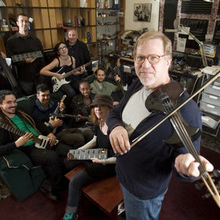 Keith McMillen (right) has been exploring new ideas for electronic music instruments for nearly 35 years, starting in 1979 with his company Zeta Music and more recently with Keith McMillen Instruments. His most recent creations are the QuNeo and QuNexus controllers, both developed using a ‘crowdfunding’ approach.
Keith McMillen (right) has been exploring new ideas for electronic music instruments for nearly 35 years, starting in 1979 with his company Zeta Music and more recently with Keith McMillen Instruments. His most recent creations are the QuNeo and QuNexus controllers, both developed using a ‘crowdfunding’ approach.
Synthtopia’s Elisabeth Lewin talked with McMillen about new instrument design, new music and how they intersect.
Synthtopia: Over the last 35 years, you’ve designed new electronic stringed instruments, MIDI mixers, created high-tech violin bows, MIDI foot pedals, a pad controller and now the QuNexus keyboard controller. Why focus on new instruments?
Keith McMillen: Being able to transition from amplified acoustic instruments into a new era of music where the computer is an interactive participant in a performance is significant.
Pretty much everything is organized around the theme of being able to play live computer music in an ensemble. It’s a complicated request that requires many components. And I’ve been chipping away at it for 30+ years. The vision gets clearer as I get closer to the goal.
Synthtopia: It seems, with Moore’s law, that what is possible grows exponentially each passing year. Does your vision of an electronic music ensemble broaden or narrow as the technology gets better?
Keith McMillen: It’s definitely a sharper focus. The goal is to have traditional instruments that have the ability to be computer input devices: with all the subtlety of their original acoustic nature, but have the computer understand all of that subtlety, and the ability for all these instruments to interact.
And just as a composer will have a style that develops over time, I think that main objective would be my “style” – the variations and the improvement on them.
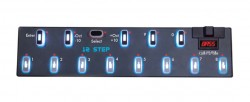 Synthtopia: Your first KMI instruments seem to have focused on enhancing the capabilities of traditional instruments and bringing new options to classical musicians. More recent instruments, though, like the 12-Step (right), QuNeo & QuNexus, seem to focus more on exploring the musical possibilities that new technologies allow. Is that accurate, and, if so, why the shift in focus?
Synthtopia: Your first KMI instruments seem to have focused on enhancing the capabilities of traditional instruments and bringing new options to classical musicians. More recent instruments, though, like the 12-Step (right), QuNeo & QuNexus, seem to focus more on exploring the musical possibilities that new technologies allow. Is that accurate, and, if so, why the shift in focus?
Keith McMillen: Well its a good question, and an accurate analysis of our output. It’s based on a couple of things: initially, I started KMI for my personal needs. I played music in 2005 with my little trio, and I realized this stuff is just clunky.
The foot switches are clunky, everything is heavy, the computer interfaces didn’t do what I wanted. To convert a violin into something a computer would understand, that was very difficult, and those elements just weren’t satisfying. I wanted to rebuild all of that.
That’s a process that is still ongoing – but the practicality of running a company purely on that, as a financial basis for a business, is difficult. If my nonprofit had a fairy godmother, our focus would be slightly different — but i think the non-acoustic input devices are equally important.
With the Zeta violin, a lot of the violinists came to me and appreciated the sound, and the clarity and the flexibility, but many of them remarked on how much faster they could play the instrument.
Now we’re hearing the same thing w the QuNexus (right). The keys are non traditional, but they’re in the traditional locations. A lot of Keyboardists are saying to us, I can play the keyboard much faster, and more accurately, and with more expression, which is contrary to what they think when they first see this little thing.
With the QuNeo, there were no good control surfaces that were multi-touch. People in the universities were exploring these things and not getting it right, so I took it on as personal challenge to put out a very responsive control surface that would be affordable.
The K-Bow (a computer-savvy bow for string instruments) I wanted for personal reasons. MIT had spent years trying to make one, and now they buy them from me (laughs).
So I guess there’s a certain hubris in taking on tough problems, and being able to come up with practical solutions. Some of that emerges in the product line, but I think we’ll see in the next few years, even in next 12 months, some of the things I’m working on now will return to the string family, and how computers are able to be controlled and serve their masters better.
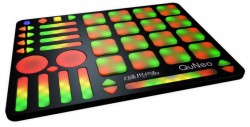 Synthtopia: In 2011, you used Kickstarter to raise funds for the development of the QuNeo multitouch controller (shown at right). You set a goal to raise $15,000, and, in the end, you managed to raise 11 times that amount.
Synthtopia: In 2011, you used Kickstarter to raise funds for the development of the QuNeo multitouch controller (shown at right). You set a goal to raise $15,000, and, in the end, you managed to raise 11 times that amount.
What did you learn from funding QuNeo via Kickstarter? Is this a model that more new instrument designers should be trying?
Keith McMillen: It was overall a fantastic experience for myself and everyone here.
People in the company were very excited and engaged on a daily basis on what was happening with Kickstarter. And, in addition to the money component, the awareness that we got from it was very important to us.
I do think that more instrument designers should take advantage of it. We learned a lot. We heard from people, and the people who participated would give us ideas. Then, in talking with them, we learned things that would have occurred to us later, I suppose. But, with all those smart people out there backing us, we learned those things much sooner.
Really, there were no negatives. It was just a fantastic way to launch something, and turn it into a product.
Synthtopia: I could imagine it going the other way, too, with random suggestions and input slowing down the development process.
Keith McMillen: We never had that problem. People would put out suggestions, and if we came back with reasons why that wouldn’t work in this format, or explain that it would cause the costs to triple on this kind of instrument, well, people would understand.
And our responses to the backers were very well received. Sometimes, they would come back with modified requests in response to our response. Some backers were very active, and some we never heard from. But for the backers from whom we had feedback, their input was very valuable.
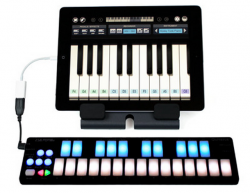 Synthtopia: Your most recent controller, the QuNexus keyboard, is designed to work with MIDI, Control Voltage, OSC and USB. And it captures an impressive range of expression, including Pressure, Location, and Velocity and polyphonic aftertouch.
Synthtopia: Your most recent controller, the QuNexus keyboard, is designed to work with MIDI, Control Voltage, OSC and USB. And it captures an impressive range of expression, including Pressure, Location, and Velocity and polyphonic aftertouch.
But it’s not designed to deliver the feel or action of a traditional keyboard. Is this intentional – or did this grow out of the goals of the project? Do you feel that we need to explore new types of keyboards and interfaces and stop recreating the past?
Keith McMillen: Oh, it’s completely intentional. If you’re trying to bring something new to an instrument that has a long history, you have to break some rules.
If you look at a piano action, it is hard to push the key down for a reason – and that’s because you’re lifting the hammer and the escapement – and you have to transfer a large amount of energy into a set of of strings.
That’s the piano. And the piano works great.
But if you’re going for something that will take advantage of all of that expertise, that is developed over hundreds of years for the piano keyboard, and then want to move it over to a new controller, then some things should be revisited.
Take this example: a lot of synthesizer controllers, and keyboard controllers, have weighted action. And you still have to push the key down half an inch or so, which takes time.
You have that, at one extreme, and then you have a glass surface, like an iPad, at the other. Somewhere in between them is the right answer.
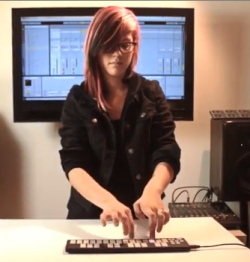 I feel really really proud of the QuNexus. The feel of the keys is perfectly attractive to fingertips. The spacing is the same as a traditional keyboard. People approach it, and they can start playing it right away. They come back, and they say, I’m 50% faster and more accurate.
I feel really really proud of the QuNexus. The feel of the keys is perfectly attractive to fingertips. The spacing is the same as a traditional keyboard. People approach it, and they can start playing it right away. They come back, and they say, I’m 50% faster and more accurate.
It’s very cool. There’s a real wonderment to it. I think it’s going to be appreciated by the musicians who use it. And you get all this expression as well, on top of it.
And you haven’t really given anything up to get all those benefits, really, except the need to press down on a key with significant force. We have learned to do that, but you can turn that muscle motion instead into speed, and expression. And it’s a very good system of transducers to accomplish that while still leaving all the virtuosity of the keyboard player intact.
Synthtopia: I posed the question on Synthtopia’s FaceBook page – what would you like to ask Keith McMillen?
Readers were excited about the QuNexus and they want more or bigger. Eric Persing, from Spectrasonics, commented, “I wish the QuNexus could do side to side vibrato like the Seaboard and the Yamaha GX-1….forward/backward like the QuNexus is not, but awkward and not ergonomic for playing. Other than this…the Qnexus I tried at NAMM was fantastic!”
And several readers on FB asked for a 4-octave or 5-octave QuNexus.
Keith McMillen: Well, you know, rest assured, if people appreciate the QuNexus in a 2-octave format, the ability to go to more keys is within our reach.
Synthtopia: Do you think that other instrument designers need to explore new kinds of keyboards, taking the idea of the piano and standing it on its head?
Keith McMillen: A keyboard controller’s goal is to model the piano action, which is certainly laudable – but it is not necessary.
When people started putting pickups on acoustic guitars, back in the 1930s, they were trying to get that acoustic guitar sound that was loud, and they failed! But what we got was Fender cranking out the Telecaster, Stratocaster – which did not sound like an acoustic guitar that was loud, but enabled a whole new type of music.
So… it’s good to have your feet in the traditional, but I don’t think you need to stay there.
Some things can’t be changed, though. I think about the violin. I know on one of my first violins, many years ago, I made the neck longer, so the heel was further up, as an experiment, to open up the reach to the higher notes. That was not met with glee.
What I could do, though, was make the upper bout removable, and that was a good combination. So, most people removed the upper bout, and lost it, and never wanted it back. But they wanted to keep that 3rd position heel to stay exactly where they expected it to be.
These were small experiments, with very definitive answers. As instrument designers, you want to ask lots of questions and do experiments and get feedback from users, but you have to have a goal in mind – an end point.
Synthtopia: So, how do you know when you’re done? I would think you could continue to adjust this and tweak that, infinitely. How do you know with any given instrument when to stop tweaking and call it finished?
Keith McMillen: When the paint’s dry, it’s done.
Just kidding!
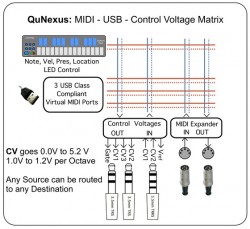 You have to articulate in words your vision from the beginning – have schematics, and proposals, and drawings and software and extrusions, molds, everything else. When that reality matches your concept as closely as you’re able to accomplish, then that’s a plausible finish point.
You have to articulate in words your vision from the beginning – have schematics, and proposals, and drawings and software and extrusions, molds, everything else. When that reality matches your concept as closely as you’re able to accomplish, then that’s a plausible finish point.
And I’d say with most of my instruments, I’ve been able to accomplish my goals. [With] the SoftStep, I wanted a small foot controller that would fit in my backpack, and be robust. It took awhile to get there, but once that was the case, it was done. And at that point I felt comfortable about shipping them out, putting them into the hands of musicians, and moving on to the next thing.
Feature creep always happens, but it’s more like what happens when you’re on stage performing, playing a piece – you’re going to augment, phrase differently, embellish, ornament. A lot of features can be added, but if they’re not important to me, personally, they may not make it into the first round of a product. But if other users request additions or changes after using the instrument for awhile, we’ll roll it into future software versions. What is important, though, is that the physical instrument, the range of response of the sensors, all of that is FINISHED.
Synthtopia: Your recent instruments, like the 12-Step, QuNeo & QuNexus, have made new music controllers affordable and available to a broader audience. Can you share some examples of some of the more interesting ways you’ve seeing these used?
Keith McMillen: We do post a lot of customers’ work on our FB page. And I’d say one in ten things really surprises me. And that’s a real kick.
One guy was on the QuNeo, and put a different note in the corner of each pad, and was doing these great quasi trills – tremolos – where he would just wiggle his finger back and forth and he’d get two or four notes out, and he could easily select which two.
When I saw that, I mean, I had known it was possible, but it was surprising, and I myself had never set that up. It allowed him to play something that was pretty wonderful. It still was well within the capability of the controller, it was just that no one had thought to do that before.
Like all music and musicians, there’s a large tendency to be like everybody else, like most people in most disciplines. But there’s also a strong, driving desire, among a few people, to do something entirely different, that no one’s done before. If we can satisfy the first group, and also enable the second, we’ve done our job.
We have more on the QuNexus and QuNeo controllers, and more reader questions, in part 2 of our interview with Keith McMillen.
About Keith McMillen
Keith received his BS in Acoustics from the University of Illinois, where he also trained in classical guitar and studied composition. He founded Zeta Music in 1979 and created new guitar effects, the first programmable MIDI audio mixer, and modern violins for the likes of Jean-Luc Ponty and Laurie Anderson. McMillen knew he had made it when a Zeta violin appeared in Playboy’s Sex and Music issue. He notes, “People bought the magazine for the violin article.”
McMillen has also worked as VP or R&D at Gibson Guitars, as Director of Engineering at Harmon Kardon and as founder and CEO of Octiv, a provider of audio signal processing technology. McMillen sold Octiv to Plantronics in 2005.
Since then, he has founded BEAM, a non-profit dedicated to promoting new music, and Keith McMillen Instruments, a new music technology company. Recently, McMilen has helped pioneer the use of Kickstarter as a tool for funding new instrument development, successfully funding and developing the QuNeo 3D MultiTouch Pad Controller.
A timeline of McMillen’s work is available at his site (pdf).
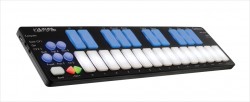

Can we hope to see the Qnexus anytime soon?
I think he said that it’s slated to ship next week or so — stay tuned for Part II of the interview here on the blog!
Sweet, thanks.
It’s cool to hear the depth of thought that goes into these products.
The challenge of translating human gesture into expressive sound involves a consideration of the human body and the control we have over our wrists, hands, breath, etc. etc., and which of those gestures are best suited to control sound. Then coming up with an interface that captures that movement with the appropriate range, resolution and scale. Finally, our virtual instruments need to be able to meaningfully assign that data to qualities of sound. Keith is building “human to VI” interfaces that consider both source (hands/feet) and destination (synth).
I think I would have difficulty getting used to the feel of a very short-throw button to control dynamics. But some of the other qualities might make it a good trade off.
Great interview.
KMI is one if the only companies that seems to be able to build new types of controllers and actually sell them in any volume!
I have to second the request for a bigger QuNexus – and also ask when do they ship!
Great interview about a very appreciable new instrument. My only consideration is the same one for pretty much all synth-centric sound: how do you establish a clear CONTEXT for the listener? Some of us are hip to the computer-based sound world, but many people are not. A bank of simple synth sounds can seem pretty bland unless someone breathes life into them within a good composition. That’s the challenge with this sleek little oddity. We’ll just see how far the Qu realm goes once its released, but even as a dedicated piano type, I think I could be convinced to use a 4-to-5-octave model. I see real merit in Keith’s design progression. It just feels as though its hitting the sweet spot.
Buchla?
I’m interested in KMI’s controllers, but how many synths can really take advantage of all the capabilities of something like the QuNexus? There are almost no synths that understand polyphonic aftertouch, for example.
If i get a QuNexus, are there synths that can really exploit the controller’s capabilities?
if the poly aftertouch works like the quneo, you can set it to whatever cc # you wish, all the same or different, and then map with midi to make it control any midi assignable item in the synth’s software. if using hardware, just break out the midi chart!
Cool – but that how does that address the polyphonic aspect? Wouldn’t the cc message affect all active voices on a chord, for example?
Hey,
I thought I’d respond to some things in the comments!
First: Each key on all of our devices sends its own set of messages– so one cc can be set up to control all voices of a single voiced synth, or (if your synth is an omni or multi-voiced synth) you can use the pressure and tilt polyphonically! We even have a method for doing polyphonic pitch bend messages with tilt. The polyphony is limited to how deep you get into your setup/customization…
We will be releasing some info/videos on how to create setups that work with these things!
Also, we’re slated to start shipping QuNexus early next week… I can keep the comments section updated as we go!
Thanks,
Matt @ KMI
I’d like to know about the future of KMI’s stringport, something I believe was purposefully left out of this conversation because of lack of support. I’m very disappointed in investing in this hardware/hardware as it seems to be completely abandoned by KMI.
KMI kicks ass! They make my VST instruments feel organic and alive. SO stoked i went in their direction when i was looking at a new midi controller. 3 months later…. STILL stoked and ultra inpired.
That is very fascinating, You are an overly professional blogger. I’ve joined your feed and look ahead to searching for extra of your wonderful post. Additionally, I have shared your web site in my social networks